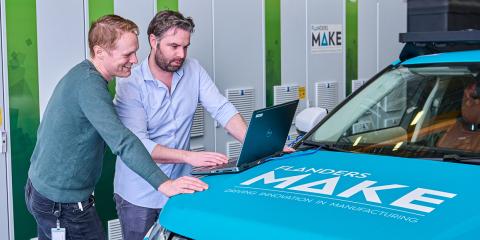Electrifying vehicles or machinery

What, why and how to electrify?
Electrification of vehicles or machines is not new, but it comes with numerous challenges. Is my machine or vehicle electrifiable? Is there a business case for retrofitting? What roadmap should I follow? What are the key success factors?
Flanders Make supports companies that want to electrify their machine (agricultural machine, forklift, rolling stock, tools, trailer, ...) or vehicle (tractor, bicycle, vessel, bus, truck, ...), but still have questions about the technical or economic feasibility. Through a step-by-step approach, Flanders Make searches together with the company for an optimal solution with short lead time and low risks.
- Design phase: based on specific requirements, the optimal architecture of the powertrain and the battery system is simulated and the first design is worked out;
- Prototype phase: the design is integrated after selecting the necessary components and reverse engineering the machine/vehicle, the prototype is tested and validated;
- Operational phase: the software functions and functional safety are further extended with multiple scenarios and extensively tested;
Step 1 - Design of powertrain and battery
The powertrain of a machine or vehicle must be compatible with the load and desired performance. We use several scalable tools for the proper selection of architecture and components. With these, an initially complex exercise can be simplified and lead to a complete evaluation and optimized operation of the powertrain in as few iterations as possible. Furthermore, we also provide an appropriate energy management strategy to meet operational objectives.
Regardless of the application, choosing the right battery type and management system is a difficult task. Even within the dominance of Li-ion, different cell types result in different trade-offs. Therefore, we employ a model-based design, selection and sizing approach to make these choices. Combined with a high-performance battery management system, optimal operation can be guaranteed.
Step 2 - Build and test prototype
Together, we build a prototype of an electrified machine or vehicle. If needed, we also produce necessary hardware parts such as electromechanical components or power electronics. During the prototype phase, we can perform testing at different hierarchical levels and for a range of power levels from quite small (<kW) to 250kW. This includes both testing of components such as batteries, electric motors/generators, gearboxes, as well as testing of complete powertrains to complete products such as (off- and on-road) vehicles.
All our testing infrastructure is fully equipped with the necessary sensors and highly trained personnel to operate the infrastructure. We help you select the most suitable infrastructure and discuss the expectations of the test. After the test, the raw data are delivered which, together with a comprehensive test report, describe the key insights for the further electrification journey.
Step 3 - Improve performance in the operational phase
The dynamic behavior (vibration, noise and motion) of a machine/vehicle, its powertrain and its subcomponents is often a crucial product attribute that straddles the line between performance, environmental footprint and human exposure. From this multi-dimensionality, we are committed to optimizing machines/vehicles and their dynamic behavior and this from both test and simulation.
To this end, we have all the necessary expertise in designing, analyzing, modeling, testing, monitoring, controlling and predicting the dynamic behavior of mechanical and mechatronic systems and complement this with our unique test infrastructure.
Example trajectory
The collaboration between e-TROVA and Flanders Make illustrates how this approach resulted in a multi-brand solution to convert old diesel trucks of different brands to an electric-powered variant within 48 hours.
